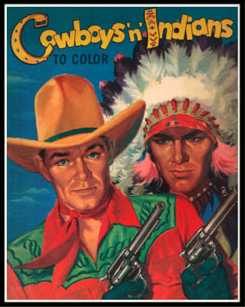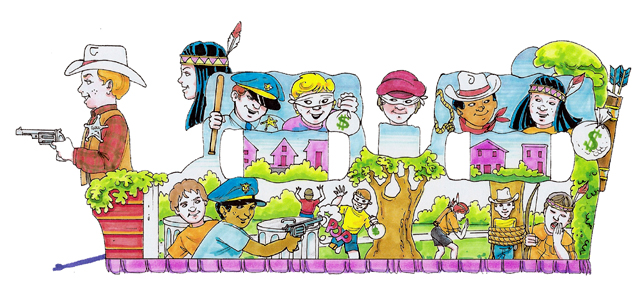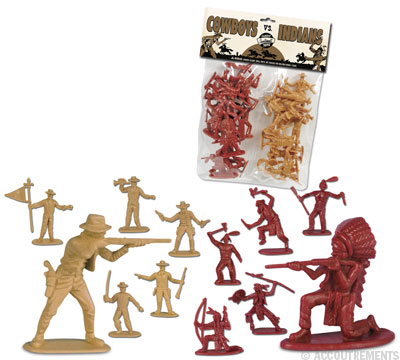But the pictures with cowboys and Indians are surprisingly revealing. They show us how commonplace stereotypes still are.

Your classic Plains chief.

Your classic mock Plains chief with buckskins and warpaint. This is the only illustration with the Indian in a superior position (an adult vs. a child). But the "Indian" looks so clownish that it negates his stature.

Buckskinned Indian with a feather and a chief, both with weapons.

A half-naked chief on horseback and three half-naked "braves," two of whom are carrying bows and arrows.
As with other scenes of conviviality, this illustration suggests that cowboys and Indians were one big happy family. In other words, that cowboys didn't kill Indians as part of America's manifest destiny. These happy-go-lucky pictures serve to whitewash the country's genocidal history.

Female version of buckskinned Indian with a feather. The pose suggests she's a friend or lover to the cowboy. The implication is that cowboys and Indians were partners in the West, with the Indians in the subordinate (female) role.
Compare this to an image of a strong Indian man holding a sexy cowgirl. You won't see anything like this except in a trashy romance novel. Why not? Because it would imply that Indians were dominant, that cowboys subordinated themselves to their interests, etc. Since John Wayne-style cowboys are our national heroes, we can't show them in anything but a dominant light.

Another buckskinned female with a feather provides a sexual counterpoint to the
Also note the two "braves" in the lower right. Both have headbands with feathers, and both carry bows and arrows. One is doing a "war whoop." They've tied up the cowboy because, well, that's what Indians do.

A chief and several half-naked "braves" with feathers. All are wielding weapons; some have tomahawks or spears rather than bows and arrows. The Indians are colored dark red because, well, they're "redskins."
Note the poses. The Indians are posed as if they're at war with the cowboys--because if they weren't friends and lovers, they must've been implacable enemies. Five of the Indians are brandishing their weapons at the cowboys, while only one cowboy is aiming at an Indian. Message: Indians are more warlike than cowboys.

Plains chiefs with drums and tipis, and buckskinned maidens with feathers. Daisy Duck in particular looks like a fetching sex object.
Note the implication--also seen in the second and third images--that anyone can become an Indian simply by donning a Halloween-style costume. In reality, Mickey and company can become cowboys by donning a hat and holster because "cowboy" is an occupation. They can't become Indians the same way.
Pretending they can diminishes the central importance of Indian culture and history. Saying anyone can become an Indian also says that being an Indian is nothing special. It says it's okay for anyone to use and exploit Indian beliefs and practices.
Conclusion
To summarize, we have Plains chiefs, half-naked or buckskinned "braves" with weapons, and sexy maidens. Period. No Indians as farmers, traders, or builders...not to mention doctors, lawyers, or rocket scientists.
People believe these stereotypical images represent reality because they see them over and over. They don't see anything else so they don't learn anything else. To most people, these are the only "real" Indians there are.
The only nonstereotypical Indian culture in these images comes from the "Northeast and Great Lakes" Disney stamp. Namely, the wigwam and collection of maple syrup. Alas, we rarely if ever see such things, so we don't associate them with Indians.

Thanks for this. I learned a few things.
ReplyDeleteWriterfella here --
ReplyDeleteAn ongoing lightning storme here caused writerfella's screen to jump and so it appeared that this post and the STAR TREK post following were one and the same post. So, writerfella answered them as a single post. Apologies.
So, the statement, "If all of these images were current to 2008, they might be a lot more meaningful. But as with any historical perspective, they only appear to be cogent to this time and place..." in fact actually belonged here.
All Best
Russ Bates
'writerfella'
All these images were "current to" a May 2008 MSN Live Search for "cowboys and Indians." They were among the most prominent images resulting from that search. Anybody who searches for "cowboys and Indians" in the future is likely to come across these images.
ReplyDeleteSo this posting is completely relevant to the issue of how we stereotype Indians today. When I post something of only historical interest, I'll be sure to let you know. This isn't it.
As a South Asian/East Indian woman, I've always been disturbed by the "cowboys vs Indians" image so racist, hateful and bigoted.
ReplyDeleteNot only is it insulting and patronizing toward Native Americans/Amerindians, it is also offensive to all South Asians/East Indians.
Thank you for the insight into this ongoing issue of representation! Keep up the research and good work!
ReplyDeleteAre you all retarded? All this crap is for kids. They boy is an a toy story "Woody" outfit for cryin out loud. Didn't your deep analysis pick up on that? All this shit is kinda based on historical fact. Sacajawea helped western explorers, (not cowboys though...), Indians and settlers really did fight, And western indians and cowboys kind of dressed like that. You cant expect everysingle chinese worker who makes this kiddy crap to produce historically accurate works of "art and culture". Anyways there also were no indian (or cowboy) rocket scientists I can guarantee that.
ReplyDeleteDid your shallow analysis overlook the fact that people learn stereotypes as children, Anonymous? If you didn't realize this, educate yourself on the subject at The Harm of Native Stereotyping: Facts and Evidence.
ReplyDeleteMost of these images come from American costumes and illustrations, not from toys made in China. So that criticism badly misses the point.
As for your other complaints, most Indians welcomed strangers rather than attacking them. And Western (Plains) Indians are stereotypical stand-ins for all Indians.
In short, the images are based on a small, unrepresentative subset of historical facts. Which means they're false or misleading--i.e., stereotypical.